2. 城市生活污水资源化利用技术国家地方联合工程实验室, 苏州 215009;
3. 江苏高校水处理技术与材料协同创新中心, 苏州 215009
2. National and Local Joint Engineering Laboratory of Resource Utilization Technology of Municipal Sewage, Suzhou 215009, China;
3. Jiangsu High Education Collaborative Innovation Center of Water Treatment Technology and Material, Suzhou 215009, China
当前, 开发并推广具有“能源再生、物质回收”功能的新型污水处理工艺已成为水污染控制领域的普遍共识[1].众多研究和工程实践表明, 通过分离设置有机物捕集和营养盐去除工序, 建立以A-B法为核心的工艺系统是实现污水处理厂能源自给的重要途径[2].在A段, 利用厌氧生物反应器或化学强化预处理技术, 最大限度地捕集水中COD并转化为甲烷等能源载体, 使B段进水呈现低C/N的特征, 再经部分亚硝化-厌氧氨氧化(PN/A)等工序去除氮素化合物[3].其中, PN/A工艺是以亚硝态氮(NO2--N)为反应中间体, 借助好氧氨氧化菌(AOB)与厌氧氨氧化菌(AMX)的协同作用, 将大部分NH4+-N转化为氮气, 同时产生少量硝态氮(NO3--N)的全自养脱氮过程[4].与传统的全程硝化-反硝化生物脱氮过程相比, PN/A工艺不依赖有机碳源, 无需设置混合液回流, 氮氧化物产量更小, 并能够在削减近60%的需氧量和75%以上的污泥产量的同时, 获得约85%的总氮去除率[2, 5].因此, PN/A工艺已被用于处理石油化工、畜禽养殖生产废水和垃圾渗滤液等高氨氮废水(>100 mg·L-1)[6].
借助颗粒污泥系统对功能菌的高效截留, PN/A工艺可以在单个反应器内实现较大的容积负荷、较小的池体尺寸和良好的运行稳定性[7, 8].但受制于有限的生物量、单一的溶液环境和严苛的控制条件, 单个连续流PN/A反应器的脱氮效能仍难以突破3 kg·(m3·d)-1[9~11].为了解决上述问题, 本文尝试在三级串联的连续流反应器中启动PN/A工艺.利用多格室分级处理和差异化运行的优势, 开展多环境因素的协同控制研究, 培养具备独立脱氮功能的全自养颗粒污泥, 从而显著提升系统的整体效能.期间, 通过序批次实验和污泥形态表征, 对颗粒污泥性能和结构演化过程进行分析, 以期为建立适用于高浓度氨氮废水处理的新方法提供理论指导.
1 材料与方法 1.1 实验装置及运行工况本实验装置是由3个容积相同的连续流完全混合式反应器(CSTR)串联组成, 每个曝气格室容积为1.6 L, 沉淀区容积为0.9 L, 装置结构图见图 1.反应器通过蠕动泵连续进水, 每个格室底部装有曝气装置, 曝气量使用转子流量计进行独立控制.三级连续流反应器置于恒温水浴缸中, 控制水温为(30±1)℃.
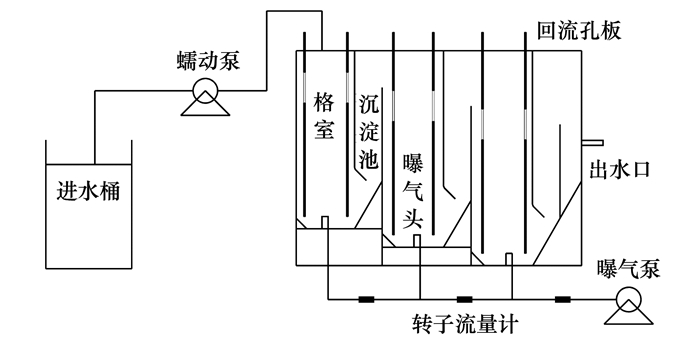
|
图 1 实验装置示意 Fig. 1 Schematic of the experimental setup |
通过不断提升进水氨氮负荷(NLR), 启动三级CSTR反应器.依据进水氨氮(NH4+-N)浓度分别为200、250、300和350 mg·L-1, 将运行过程分为Ⅰ~Ⅳ共4个阶段, 如表 1所示.在同一阶段内, 当出水NH4+-N浓度低于10 mg·L-1时, 逐级缩短反应器水力停留时间(HRT), 同时起到提升进水负荷和淘洗絮状污泥的作用.依据DO浓度、DO/NH4+-N比值和游离氨(FA)含量, 独立控制各格室的曝气强度、进水pH和碱度投加, 实现对CSTR反应器的运行调控.
|
|
表 1 反应器启动过程的主要操作参数 Table 1 Main operating parameters in the start-up of the reactor |
1.2 接种污泥与进水水质
为保证接种污泥的均匀性, 取实验室内连续流反应器中的PN/A颗粒污泥[12], 经机械破碎和筛分, 将粒径在0.2~0.5 mm的颗粒接种到3个格室中, 起始污泥浓度(MLSS)均为3000 mg·L-1.
反应器进水为人工配置的无机高氨氮废水, 模拟A-B工艺中经A段高效去除COD后的B段进水.进水以碳酸氢钠和氯化铵充当碳、氮源, 无机碳与氨氮的质量比(TIC/NH4+-N)在1.0:1~1.4:1, 辅以少量磷酸二氢钾、硫酸镁和微量元素, 调节pH在7.6~8.0[13].
1.3 颗粒污泥活性的测定为评价颗粒污泥的脱氮活性, 需定期从各格室中取出10 mL颗粒污泥, 经生理盐水清洗后, 置于150 mL锥形瓶与90 mL基质溶液混合.初始NH4+-N浓度控制在200 mg·L-1, pH=7.8.锥形瓶用透气硅胶塞盖好, 置于30℃下振荡反应.期间, 设置两种不同转速300 r·min-1和120 r·min-1, 分别模拟颗粒污泥在高、低曝气强度下的脱氮过程.依据在一定时间段内氮素含量的变化与污泥量的比值, 计算NH4+-N、TN比去除速率(以N/VSS计), 即q(NH4+-N)和q(TN), 单位mg·(g·h)-1[14].
1.4 指标分析方法NH4+-N、NO3--N、NO2--N和TN指标分别采用纳氏试剂光度法、紫外分光光度法、N-(1-萘基)-乙二胺光度法和过硫酸钾氧化-紫外分光光度法测定. MLSS和MLVSS浓度采用标准重量法测定.溶液pH、溶解氧(DO)和温度采用多功能水质分析仪(903P般特)测定.颗粒粒径分布使用筛分法确定.重要参数的计算公式如下.
亚硝累积率:

|
水中游离氨(FA)浓度[15]:

|
污泥去除负荷:

|
式中, NH4+-N、ΔTN和MLSS单位为mg·L-1, 温度T单位为K.
污泥形态使用OLYMPUS CX41型显微镜观测.使用甲醛-NaOH法[16]提取污泥中胞外聚合物(EPS).其中, 蛋白质(PN)和聚多糖(PS)含量分别采用Lowry法和苯酚-硫酸法进行测定[17], 单位mg·g-1.
2 结果与讨论 2.1 反应器的启动过程在第I阶段(第1~11 d), 通过独立调节曝气强度, 控制3个格室内DO浓度分别为1.5、1.4和0.9 mg·L-1, NH4+-N浓度呈现梯度递减趋势, 对应的DO/NH4+-N比值约为0.01、0.02和0.32.保持限制曝气状态将有助于防止亚硝酸氧化菌(NOB)增殖对PN/A反应的破坏, 这对于连续流反应器尤为重要[18, 19].期间, 颗粒污泥以亚硝化功能为主, 出水NO2--N累积率稳定在90%左右.经逐级缩短HRT, 反应器对NH4+-N和TN去除率分别从86%和7%上升至98%和35%, 如图 2所示.考虑到亚硝化反应对碱度的消耗, 进水TIC/NH4+-N保持在1.4:1.与之类似, 在第Ⅱ和Ⅲ阶段, 提高进水NH4+-N浓度和缩短反应器HRT都会导致NH4+-N去除率出现规律性波动, 出水NO2--N浓度持续下降.在更高的NLR条件下运行, 需适当提高各格室的曝气强度, 以维持合适的DO/NH4+-N比值(< 0.13).运行至第53 d, 反应器对NH4+-N和TN去除率分别达到99%和73%, 出水NO2--N累积率低于60%, 总氮去除负荷达到5.3 kg·(m3·d)-1.此时, 污泥去除单位TN产生的NO3--N(f值)为0.14, 接近PN/A反应的计量学理论值0.11[13, 20].反应器表现出较强的全自养脱氮性能.
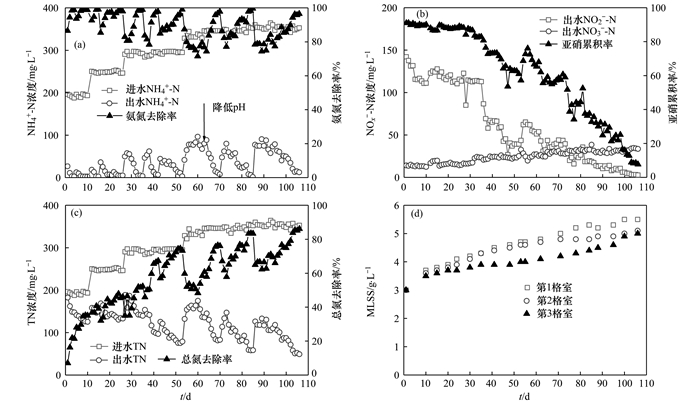
|
图 2 三级连续流反应器脱氮性能与各格室MLSS变化 Fig. 2 Variations in the nitrogen removal performance of the three-stage continuous flow reactor and MLSS concentrations in each compartment |
在第Ⅳ阶段初期(第54~62 d), 当进水NH4+-N浓度进一步提升至350 mg·L-1时, 反应器对NH4+-N、TN去除率分别降至80%和50%左右, 出水NO2--N浓度明显升高.经过较长时间的连续运行, 更高的氨氮容积负荷使得第1、2格室的污泥量略大于第3格室[图 2(d)].各格室的总氮污泥去除负荷(以N/VSS计, 下同)遵循:第3格室0.48 g·(g·d)-1>第2格室0.38 g·(g·d)-1>第1格室0.30 g·(g·d)-1.这是因为在弱碱性pH条件下, 第1、2格室内的FA浓度(33.4~35.0 mg·L-1和20.1~22.6 mg·L-1)要高于第3格室的水平(5.4~10.4 mg·L-1), 前者对功能菌(尤其是AMX)活性具有更强的抑制作用[21, 22].
从第63 d起, 将进水pH下调至7.7, 并削减碳酸氢盐投加量, 控制TIC/NH4+-N=1.0:1, 将第1和2格室内的FA浓度限制在15.5 mg·L-1和7.4 mg·L-1以下.通过减小FA对前2个格室污泥活性的负面影响, 反应器整体脱氮性能得到了有效恢复, 第70 d的出水NH4+-N浓度已降至8 mg·L-1以下.此后, 继续采用逐级缩短HRT和维持限制曝气的方法, 最终使反应器在NLR为8.4 kg·(m3·d)-1的条件下, 去除了进水中超过96%的NH4+-N和约86%的TN, f值稳定在0.11.这意味着三级连续流反应器的总氮去除负荷达到了7.2 kg·(m3·d)-1, 远超以往CANON等自养脱氮工艺0.4~2.8 kg·(m3·d)-1的水平, 相当于传统活性污泥法的50~100倍[7~9].同时, 各格室污泥量进一步增长, MLVSS/MLSS值约为0.87, 总氮污泥去除负荷遵循:第1格室0.43 g·(g·d)-1>第2格室0.35 g·(g·d)-1>第3格室0.34 g·(g·d)-1.上述结果表明, 尽管接种污泥类型相同, 但各格室的NLR梯度仍会导致颗粒性能出现差异化现象.
2.2 颗粒污泥活性的差异前期研究表明, 不同曝气强度对PNA颗粒污泥脱氮性能的影响可以在一定程度上反映颗粒的结构密实度与功能成熟度[10, 23].由图 3可知, 在第11 d, 各格室颗粒污泥的脱氮活性相差很小, 都呈现明显的亚硝化状态.采用高曝气强度能够显著提高污泥中AOB对氨氮的降解速率, 获得更大的q(NH4+-N)值, 但对应的q(TN)值略低于低曝气的情形.这主要是因为接种污泥经机械破碎后结构密实度较低, 无法有效限制DO在颗粒内部的渗透范围, 不利于保持AMX的功能活性.
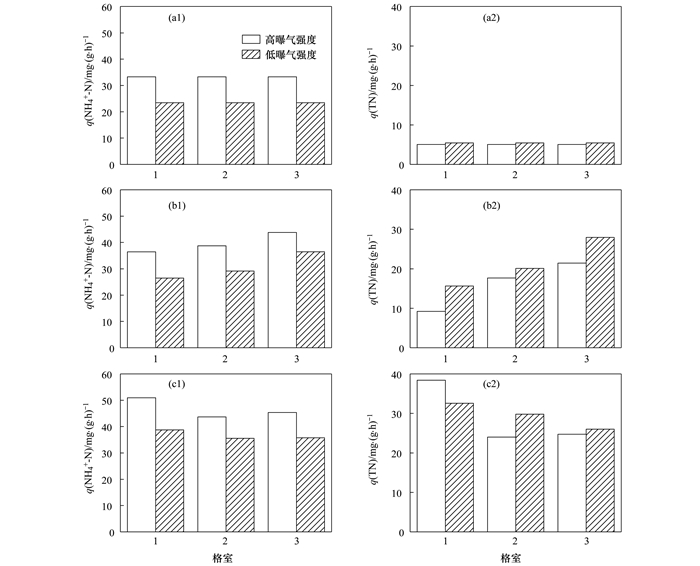
|
(a)第11d;(b)第54d;(e)第106d 图 3 不同运行阶段, 各格室颗粒污泥的脱氮活性 Fig. 3 Nitrogen removal activity of granular sludge in the different compartments of the reactor during various operating periods |
当反应器运行至第54 d时, 颗粒污泥的脱氮活性从第1~3格室逐渐增大, 这与前文针对FA抑制作用的分析是一致的.在高、低曝气强度下, q(TN)值的显著差异也说明颗粒内部的氧传质阻力仍然较低.为营造适宜AMX生长的微生境, 对连续流反应器采用限制曝气和降低FA浓度的控制策略是非常必要的.
在第106 d, 各格室污泥的脱氮活性较前阶段又有明显提升. 3个污泥样品的q(NH4+-N)值都在高曝气强度下获得了更高的测定值, 且第1格室污泥的q(TN)值也出现了类似的情况, 即提高曝气强度对PN/A反应起到了促进作用.这表明高运行负荷使得第1格室的颗粒污泥结构更加密实, 成熟度要优于第2和3格室.此外, 在所有序批次实验中, 颗粒污泥脱氮过程的f值始终低于0.15, NO3--N产量处于低水平, NOB增殖得到了有效控制.
2.3 污泥形态结构的变化如前所述, AMX等功能菌活性随着反应器性能的提升而持续增强, 这种变化在污泥外观形态上也有所体现, 如图 4所示.接种污泥的平均粒径为0.3 mm, 颜色呈棕黄色, 大多数为不规则形态.运行期间, 通过控制反应器HRT, 对污泥始终保持了较大的水力选择压.在第Ⅲ阶段末期, 第1格室污泥的平均粒径已增长至0.8 mm, 颗粒结构更加密实, 棕红色内核被半透明絮体包裹, 其他格室污泥形态的变化与之相似.当进水NLR达到8.4 kg·(m3·d)-1时, 第1格室污泥呈深红棕色, 颗粒密实且表面光滑, 平均粒经增至1.0 mm.
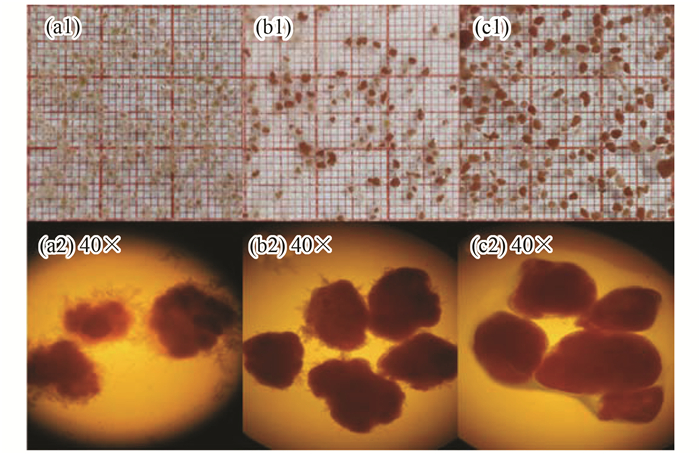
|
(a)第11d;(b)第54d;(c)第106d 图 4 第1格室颗粒污泥形态的变化 Fig. 4 Variations in the morphology of granular sludge in the first compartment |
作为维持污泥形态的结构性物质, 胞外聚合物(EPS)被认为是建立PN/A颗粒内部差异化微生境的重要基础, 其以高分子蛋白质(PN)和聚多糖(PS)物质为主[24, 25].在本文中, 将PN和PS含量相加代表颗粒污泥的EPS总量.有研究表明, AMX和共生异养菌在增殖过程中都会产生大量EPS, 以实现形成基质梯度、黏附菌体细胞和抵御不良环境等功能[10, 25].在启动期间, 颗粒污泥的EPS含量不断累积, 如表 2所示.
|
|
表 2 不同运行阶段, 各格室内颗粒污泥的EPS含量 Table 2 EPS content of granular sludge in the different compartments of the reactor during various operating periods |
其中, 第1格室污泥的PN与PS总量增大了约2.4倍, 并高于第2和3格室的水平.与以往的报道类似[26], PN含量的增长速率要明显快于PS.更大的PN/PS比值意味着污泥表面疏水性的增强, 这与颗粒密实度和成熟度的变化是一致的[27, 28].由图 5可知, 颗粒污泥在低曝气强度下的q(TN)值与EPS总量呈现良好的线性相关(R2>0.97).在工程实践中, 开展污泥活性与结构参数的相关性研究将为客观评价PN/A颗粒污泥性能提供重要参考.
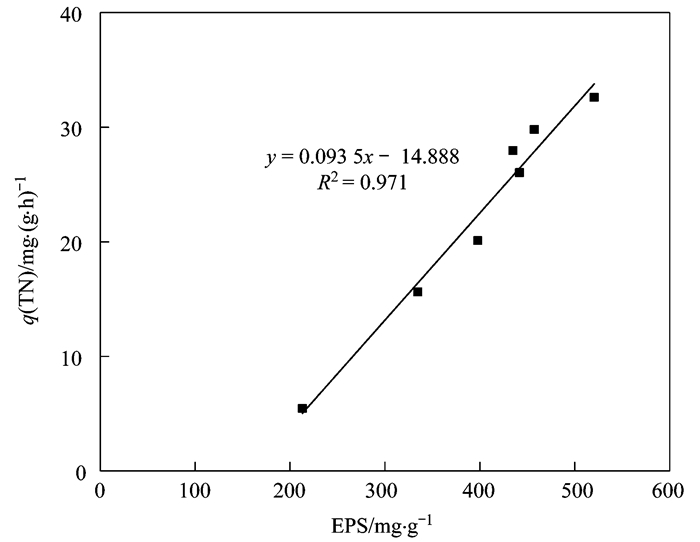
|
图 5 颗粒污泥脱氮活性与EPS含量之间的线性拟合关系 Fig. 5 Linear fitting relationship between the nitrogen removal activity and EPS contents of granular sludge |
(1) 以破碎后的PN/A颗粒为接种污泥, 通过调节进水NH4+-N浓度和反应器HRT, 在106 d内成功启动了三级全自养脱氮颗粒污泥反应器.当进水NH4+-N浓度为350 mg·L-1时, 将HRT缩短至3.0 h, 反应器对NH4+-N的去除率约为96%, 对应的TN去除负荷可达7.2 kg·(m3·d)-1, 远高于以往文献报道的数值, 且出水NO3--N浓度始终处于较低水平.
(2) 启动过程中, 协同控制反应器负荷、各格室DO水平和FA浓度是持续提升污泥脱氮活性的关键方法.采用序批次实验测定不同曝气强度下的q(NH4+-N)和q(TN)值, 能够反映颗粒污泥结构与功能的成熟度, 并为三级连续流反应器的调控提供理论指导.
(3) 随着污泥粒径的持续增大, 颗粒结构愈加密实, 表面更加光滑, 颜色由棕黄色变为深红棕色.期间, 颗粒污泥的q(TN)值与EPS含量呈现良好的线性相关(R2>0.97), 这说明颗粒污泥形态演变对反应器脱氮性能提升存在重要影响.
| [1] | Gu Y F, Li Y, Li X Y, et al. Energy self-sufficient wastewater treatment plants:feasibilities and challenges[J]. Energy Procedia, 2017, 105: 3741-3751. DOI:10.1016/j.egypro.2017.03.868 |
| [2] | Gao H, Scherson Y D, Wells G F. Towards energy neutral wastewater treatment:methodology and state of the art[J]. Environmental Science:Processes & Impacts, 2014, 16(6): 1223-1246. |
| [3] | Wan J F, Gu J, Zhao Q, et al. COD capture:a feasible option towards energy self-sufficient domestic wastewater treatment[J]. Scientific Reports, 2016, 6: 25054. DOI:10.1038/srep25054 |
| [4] | Li J L, Zhang L, Peng Y Z, et al. NOB suppression in partial nitritation-anammox (PNA) process by discharging aged flocs:performance and microbial community dynamics[J]. Chemosphere, 2019, 227: 26-33. DOI:10.1016/j.chemosphere.2019.04.023 |
| [5] | Morales N, Val del Río á, Vázquez-Padín J R, et al. Integration of the anammox process to the rejection water and main stream lines of WWTPs[J]. Chemosphere, 2015, 140: 99-105. DOI:10.1016/j.chemosphere.2015.03.058 |
| [6] |
何岩, 赵由才, 周恭明. 高浓度氨氮废水脱氮技术研究进展[J]. 工业水处理, 2008, 28(1): 1-4. He Y, Zhao Y C, Zhou G M. Research process on the denitrogenation of highly concentrated ammonium-nitrogen wastewater[J]. Industrial Water Treatment, 2008, 28(1): 1-4. DOI:10.3969/j.issn.1005-829X.2008.01.001 |
| [7] | Wang L, Zheng P, Chen T T, et al. Performance of autotrophic nitrogen removal in the granular sludge bed reactor[J]. Bioresource Technology, 2012, 123: 78-85. DOI:10.1016/j.biortech.2012.07.112 |
| [8] | Vlaeminck S E, Cloetens L F F, Carballa M, et al. Granular biomass capable of partial nitritation and anammox[J]. Water Science & Technology, 2008, 58(5): 1113-1120. |
| [9] | Kent T R, Bott C B, Wang Z W. State of the art of aerobic granulation in continuous flow bioreactors[J]. Biotechnology Advances, 2018, 36(4): 1139-1166. DOI:10.1016/j.biotechadv.2018.03.015 |
| [10] | Vlaeminck S E, Terada A, Smets B F, et al. Aggregate size and architecture determine microbial activity balance for one-stage partial nitritation and anammox[J]. Applied and Environmental Microbiology, 2010, 76(3): 900-909. DOI:10.1128/AEM.02337-09 |
| [11] | Hubaux N, Wells G, Morgenroth E. Impact of coexistence of flocs and biofilm on performance of combined nitritation-anammox granular sludge reactors[J]. Water Research, 2015, 68: 127-139. DOI:10.1016/j.watres.2014.09.036 |
| [12] |
陈希, 王建芳, 钱飞跃, 等. 连续流与序批式组合运行启动高性能CANON反应器[J]. 化工学报, 2018, 69(4): 1695-1702. Chen X, Wang J F, Qian F Y, et al. Start-up of high-performance CANON reactor by alternating continuous flow and sequencing batch operation modes[J]. CIESC Journal, 2018, 69(4): 1695-1702. |
| [13] | Qian F Y, Wang J F, Shen Y L, et al. Achieving high performance completely autotrophic nitrogen removal in a continuous granular sludge reactor[J]. Biochemical Engineering Journal, 2017, 118: 97-104. DOI:10.1016/j.bej.2016.11.017 |
| [14] |
王书永, 钱飞跃, 王建芳, 等. 有机物对亚硝化颗粒污泥中功能菌活性的影响[J]. 环境科学, 2017, 38(1): 269-275. Wang S Y, Qian F Y, Wang J F, et al. Impact of biodegradable organic matter on the functional microbe activities in partial nitrification granules[J]. Environmental Science, 2017, 38(1): 269-275. |
| [15] | Yamamoto T, Takaki K, Koyama T, et al. Long-term stability of partial nitritation of swine wastewater digester liquor and its subsequent treatment by anammox[J]. Bioresource Technology, 2008, 99(14): 6419-6425. DOI:10.1016/j.biortech.2007.11.052 |
| [16] | Liang Z W, Li W H, Yang S Y, et al. Extraction and structural characteristics of extracellular polymeric substances (EPS), pellets in autotrophic nitrifying biofilm and activated sludge[J]. Chemosphere, 2010, 81(5): 626-632. DOI:10.1016/j.chemosphere.2010.03.043 |
| [17] |
王琰, 钱飞跃, 王建芳, 等. 亚硝化颗粒污泥中EPS提取方法与组成特性的比较研究[J]. 环境科学学报, 2015, 35(11): 3515-3521. Wang Y, Qian F Y, Wang J F., et al. Comparative study on extraction methods and composition of extracellular polymeric substances (EPS) in granular nitrosation sludge[J]. Acta Scientiae Circumstantiae, 2015, 35(11): 3515-3521. |
| [18] | Bartrolí A, Pérez J, Carrera J. Applying ratio control in a continuous granular reactor to achieve full nitritation under stable operating conditions[J]. Environmental Science & Technology, 2010, 44(23): 8930-8935. |
| [19] | Poot V, Hoekstra M, Geleijnse M A A, et al. Effects of the residual ammonium concentration on NOB repression during partial nitritation with granular sludge[J]. Water Research, 2016, 106: 518-530. DOI:10.1016/j.watres.2016.10.028 |
| [20] | Third K A, Sliekers A O, Kuenen J G, et al. The CANON system (completely autotrophic nitrogen-removal over nitrite) under ammonium limitation:interaction and competition between three groups of bacteria[J]. Systematic and Applied Microbiology, 2001, 24(4): 588-596. DOI:10.1078/0723-2020-00077 |
| [21] | Li S, Chen Y P, Li C, et al. Influence of free ammonia on completely autotrophic nitrogen removal over nitrite (CANON) process[J]. Applied Biochemistry and Biotechnology, 2012, 167(4): 694-704. DOI:10.1007/s12010-012-9726-4 |
| [22] | Fernández I, Dosta J, Fajardo C, et al. Short- and long-term effects of ammonium and nitrite on the Anammox process[J]. Journal of Environmental Management, 2012, 95(S1): S170-S174. |
| [23] | Qian F Y, Chen X, Wang J F, et al. Differentiation in nitrogen-converting activity and microbial community structure between granular size fractions in a continuous autotrophic nitrogen removal reactor[J]. Journal of Microbiology and Biotechnology, 2017, 27(10): 1798-1807. DOI:10.4014/jmb.1705.05042 |
| [24] | More T T, Yadav J S S, Yan S, et al. Extracellular polymeric substances of bacteria and their potential environmental applications[J]. Journal of Environmental Management, 2014, 144: 1-25. |
| [25] | Hou X L, Liu S T, Zhang Z T. Role of extracellular polymeric substance in determining the high aggregation ability of anammox sludge[J]. Water Research, 2015, 75: 51-62. DOI:10.1016/j.watres.2015.02.031 |
| [26] | Yan L L, Liu Y, Wen Y, et al. Role and significance of extracellular polymeric substances from granular sludge for simultaneous removal of organic matter and ammonia nitrogen[J]. Bioresource Technology, 2015, 179: 460-466. DOI:10.1016/j.biortech.2014.12.042 |
| [27] | Zhang H F, Yu H H, Zhang L H, et al. Stratification structure of polysaccharides and proteins in activated sludge with different aeration in membrane bioreactor[J]. Bioresource Technology, 2015, 192: 361-366. DOI:10.1016/j.biortech.2015.05.025 |
| [28] | Zhao Y P, Feng Y, Li J Q, et al. Insight into the aggregation capacity of anammox consortia during reactor start-up[J]. Environmental Science & Technology, 2018, 52(6): 3685-3695. |
 2019, Vol. 40
2019, Vol. 40


